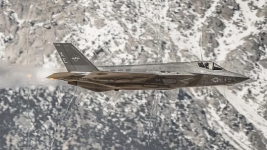HA! What does this Naval aviator know apparently he's never heard of our resident expert randomradio expertise when it comes to this specific topic.

Naval Aviator explains why the F-35 can give the F-22 fits in BVR while 4th Gen Fighters have 1:100 chance at best to beat the Raptor
‘Where the F-35 Lightning II would give the F-22 fits would be BVR. The primary advantage the Raptor has, first detection, is negated.’ Adam Daymude, US Navy EA-18G Growler pilot.
The Lockheed Martin F-22A Raptor is the world’s first stealthy air dominance fighter. Its radar, weapons control and electronic warfare systems work together as one integrated unit. The Raptor combines stealth, maneuverability and the ability to fly long distances at supersonic speeds — or “supercruise” — in performance of air superiority and air-to-ground missions. Furthermore, it requires less maintenance than older fighters.
From the very beginning, the F-22A exceeded the USAF’s expectations, and during exercises and deployments, it proved to be more than a match for any fighter opposing it.
During the highly realistic Exercise Northern Edge 2006,
the F-22 proved itself against as many as 40 “enemy aircraft” during simulated battles. The Raptor pilots achieved a 108-to-zero “kill” ratio against the best F-15, F-16 and F-18 “adversaries.”
Still, the Raptor is not invulnerable, though it makes life very difficult for opponents.
What modern fighter planes have the best chances against the F-22?
Adam Daymude, former US Navy EA-18G Growler pilot, explains
on Quora;
‘As Joe Rogan would say, let’s look at the tale of the tape.
‘F-22 Raptor capabilities/qualities:
1. First and foremost, extremely low RADAR cross section (RCS).
2. Infrared signature reduction.
3. Supercruise (flying supersonic without the need for afterburners).
4. 2-D thrust vectoring.
5. All aspect missiles.
6. AESA RADAR.
7. Sensor fusion.
8. Missile Launch Detection systems.
‘With the exception of not having a
Helmet Mounted Cueing System (HMCS), this is basically a wish list for any fighter. It’ll be hard to beat for sure but not necessarily impossible.
‘Let’s start with
gen 4 or 4.5 aircraft, and not just any gen 4. How about the best of the best, one undefeated in aerial combat:
‘F-15C Eagle capabilities/qualities:
1. Not LO.
2. Slight infrared signature reduction.
3. Supersonic, but requires afterburner.
4. No thrust vectoring.
5. All aspect missiles.
6. AESA RADAR.
7. Limited sensor fusion.
‘In a BVR fight, where we all want to be, it just doesn’t stand a chance. The Raptor will see the Eagle first, even though the Eagle’s AESA RADAR does help somewhat with detection range, though not enough to make a difference. Also, the F-22 will be higher and faster meaning it can shoot from further out. Most likely result will be a kill from the Raptor before the Eagle even knew it was there.
‘Now if we did end up in a dogfight where the primary advantage of the Raptor is mitigated (
low RCS) I do like the chances of some gen 4 aircraft, particularly small and nimble aircraft like the F-16 but you have to get there first. All in all, though, I would give gen 4 aircraft a 1:100 chance at best and they’d have to surprise the Raptor.’
Daymude continues;
‘That leaves us with gen 5 aircraft and there’s only one choice here:
‘F-35 Battle Penguin…sorry…
Lightning II.
‘I won’t list them all out here but the capabilities and qualities are comparable to the F-22 with a couple of changes.
1. Slower and no supercruise.
2. No thrust vectoring.
3. Next gen sensor fusion and avionics.
4. Improved network capabilities.
‘Dogfighting, I’d give the F-35 a puncher’s chance due to its HMCS with the AIM-9X but I think it would lose more often than win. Where it would give the F-22 fits would be BVR. The primary advantage the Raptor has, first detection, is negated; both aircraft would have troubles…on their own. Where the Battle Penguin absolutely rules is in its network capability, where it can fuse the variety of detection sources, internal AND external, to form one single air-to-air picture. Stealth is great, but you can’t be virtually invisible from all angles. That means if you spread your sensors out in a wide array, you would have a better chance at detection. Not great, just better. And that little bit may be enough to tip the scales.’
Daymude concludes;
‘To summarize, any gen 4 aircraft, NATO or otherwise, would only stand a chance if it surprised the Raptor and got into a dogfight. The F-35 is the only aircraft I’d feel comfortable in taking it on.’
Naval Aviator explains why the F-35 can give the F-22 fits in BVR while 4th Gen Fighters have 1:100 chance at best to beat the Raptor

theaviationgeekclub.com








 .
.





